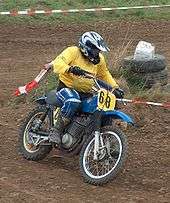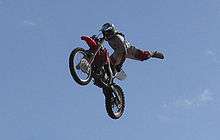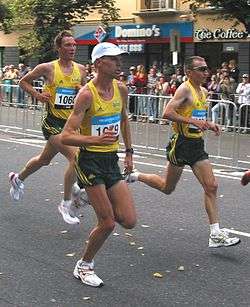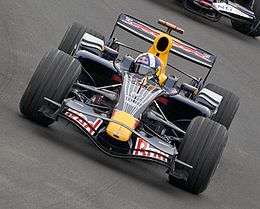Motocross
Motocross is a form of off-road motorcycle racing held on enclosed off-road circuits. Motocross is one of the most physically demanding sports as riders use almost all muscles and shift weight to balance throughout the whole ride.The sport evolved from motorcycle trials competitions held in the United Kingdom.[1][2]
History
Motocross first evolved in the U.K. from motorcycle trials competitions, such as the Auto-Cycle Clubs's first quarterly trial in 1909 and the Scottish Six Days Trial that began in 1912.[1][2] When organisers dispensed with delicate balancing and strict scoring of trials in favour of a race to become the fastest rider to the finish, the activity became known as "hare scrambles", said to have originated in the phrase, "a rare old scramble" describing one such early race.[1] Though known as scrambles racing in the United Kingdom, the sport grew in popularity and the competitions became known internationally as "motocross racing", by combining the French word for motorcycle, motocyclette, or moto for short, into a portmanteau with "cross country".[1] The first known scramble race took place at Camberley, Surrey in 1924.[3] During the 1930s the sport grew in popularity, especially in Britain where teams from the Birmingham Small Arms Company (BSA), Norton, Matchless, Rudge, and AJS competed in the events. Off-road bikes from that era differed little from those used on the street. The intense competition over rugged terrain led to technical improvements in motorcycles. Rigid frames gave way to suspensions by the early 1930s, and swinging fork rear suspension appeared by the early 1950s, several years before manufacturers incorporated it in the majority of production street bikes.[4] The period after World War II was dominated by BSA, which had become the largest motorcycle company in the world.[4] BSA riders dominated international competitions throughout the 1940s.[4]

In 1952 the FIM, motorcycling's international governing body, set up an individual European Championship using a 500 cc engine displacement formula.[4] In 1957 it was upgraded to World Championship status.[4] In 1962 a 250 cc world championship was established.[4] In the smaller 250 cc category companies with two-stroke motorcycles came into their own. Companies such as Husqvarna from Sweden, CZ from the former Czechoslovakia, Bultaco from Spain and Greeves from England became popular due to their lightness and agility.[4] Stars of the day included BSA-works riders Jeff Smith and Arthur Lampkin, with Dave Bickers, Joe Johnson and Norman Brown on Greeves. By the 1960s, advances in two-stroke engine technology meant that the heavier, four-stroke machines were relegated to niche competitions.[4] Riders from Belgium and Sweden began to dominate the sport during this period.[2][5] Motocross arrived in the United States in 1966 when Swedish champion, Torsten Hallman rode an exhibition event against the top American TT riders at the Corriganville Movie Ranch also known as Hopetown in Simi Valley, California. The following year Hallman was joined by other motocross stars including Roger DeCoster, Joël Robert, and Dave Bickers. They dominated the event, placing their lightweight two-strokes into the top six finishing positions.[6][7] Motocross began to grow in popularity in the United States during this period, which fueled an explosive growth in the sport.[8]
By the late 1960s Japanese motorcycle companies began challenging the European factories for supremacy in the motocross world. Suzuki claimed the first world championship for a Japanese factory when Joël Robert won the 1970 250 cc crown.[9] The first stadium motocross event took place in 1972 at the Los Angeles Coliseum.[10] In 1975 a 125 cc world championship was introduced.[2] European riders continued to dominate motocross throughout the 1970s but, by the 1980s, American riders had caught up and began winning international competitions.[11]
During the late 1970s and early 1980s, Japanese motorcycle manufacturers presided over a boom period in motocross technology. The typical two-stroke air-cooled, twin-shock rear suspension machines gave way to machines that were water-cooled and fitted with single-shock absorber rear suspension. In the 1990s, America's leading motorcycle sport governing body, the AMA, increased the allowable displacement limit for four stroke powered machines in the AMA motocross championship, due to the low relative power output of a four stroke engine, compared to the then-dominating two stroke design. By 1994, the displacement limit of a four stroke power motocross bike was up to 550 cc in the 250 class, to incentivize manufactures to further develop the design for use in motocross.[12] By 2004 all the major manufacturers had begun competing with four-stroke machines. European firms also experienced a resurgence with Husqvarna, Husaberg, and KTM winning world championships with four-stroke machinery.
The sport evolved with sub-disciplines such as stadium events known as supercross and arenacross held in indoor arenas. Classes were also formed for all-terrain vehicles. Freestyle motocross (FMX) events where riders are judged on their jumping and aerial acrobatic skills have gained popularity, as well as supermoto, where motocross machines race both on tarmac and off-road. Vintage motocross (VMX) events take place – usually for motorcycles predating the 1975 model year.[13] Many VMX races also include a "Post Vintage" portion, which usually includes bikes dating until 1983.
Major competitions
FIM Motocross World Championship

The FIM Grand Prix Motocross World Championship is predominantly held in Europe, but also includes events in North America, South America, Asia, Australia, and Africa.[14] It is the major Motocross series worldwide. There are three classes: MXGP for 450cc machines, MX2 for 250cc machines, and Women's MX. Competitions consist of two races which are called motos with a duration of 30 minutes plus two laps.
AMA Motocross Championship
The AMA Motocross Championship begins in mid May and continues until late August. The championship consists of twelve rounds at twelve major tracks all over the continental United States. There are three classes:[15] the 250cc Motocross Class for 150–250 cc 4-stroke machines, the 450cc Motocross Class for 251–450 cc 4-stroke machines and a 250cc Women's Class, using the same rules as men's 250cc.
Motocross des Nations

The annual Motocross des Nations is held at the end of the year when National and World Championship series have ended.[4] The competition involves teams of three riders representing their nations.[2] Each rider competes in a different class (MX1, MX2, and "Open"). There are three motos with two classes competing per moto. The location of the event changes from year to year. The United States, Belgium and Great Britain have had the greatest success.[11]
British Motocross Championship
Th British Motocross Championship is the main UK off-road competition and organised into classes of MX1 and MX2. MX1 is for 250 cc to 450 cc (fourstroke) and MX2 for 175 cc to 250 cc fourstroke motorcycles.[16] In 2007 an additional youth class, the MXY2 class, was added to the programme at selected rounds.[17]
A "Veterans" series was introduced in 2009 with just two rounds but the demand for places was so high that from 2011 the Veterans series will have three rounds, held over six races.[18]
Sports derived from motocross
A number of other types of motorcycle sport have been derived from Motocross.
Freestyle

Freestyle Motocross (FMX), a relatively new variation of supercross started by the South African champion, Marco Urzi, does not involve racing and instead it concentrates on performing acrobatic stunts while jumping motocross bikes. The winner is chosen by a group of judges. The riders are scored on style, level of trick difficulty, best use of the course, and frequently, crowd reactions. FMX was introduced to the X Games and mainstream audiences in 1999.
SuperMoto

Supermoto uses motocross bikes converted for racing on tracks consisting of three sections: flat dirt, dirt obstacles, and paved road. The bikes have special road-racing tires with grooved tread to grip both the pavement and dirt. Some tracks for these race events have jumps, berms, and whoops like motocross tracks. For special events, the Supermoto track may incorporate metal ramps for jumps that can be disassembled and taken to other locations. Supermoto races may take place at modified go-kart tracks, road racing tracks, or even street racing tracks. There are also classes for children, such as the 85 cc class.
Supermoto began in the US the late 1970s when TV journalist Gavin Trippe envisioned a racing event that would prove who the best motorcycle racer was. From 1980 to 1985, he organized a yearly event called "The Superbikers", which pitted the top riders from three disciplines, flat track, road racing, and motocross against one another on modified bikes raced on special tracks on the television show. Its first exposure to a wide audience came on the American television program ABC's Wide World of Sports in 1979. After 1985, the sport declined and received little exposure in the US, but in Europe, it started gaining popularity, and in 2003 it was revived in the US, when the name became Supermoto.
ATV/Quad Motocross

Throughout the United States and the United Kingdom there are many quad racing clubs with enduro and quadcross sections. GNCC Racing began around 1980 and includes hare scramble and enduro type races. To date, events are mainly held in the eastern part of the United States. GNCC racing features many types of obstacles such as, hill climbing, creek and log crossings, dirt roads and wooded trails.
The ATV National Motocross Championship was formed around 1985.[19] ATVMX events are hosted at motocross racetracks throughout the United States. ATVMX consists of several groups, including the Pro (AMA Pro) and Amateur (ATVA) series. Championship mud racing (CMR)[20] saw its infancy in 2006 as leaders of the ATV industry recognized a need for uniformity of classes and rules of various local mud bog events. Providing standardized rules created the need for a governing body that both racers and event promoters could turn to and CMR was born. Once unified, a true points series was established and lead to a national championship for what was once nothing more than a hobby for most. In 2007 the finalized board of directors was established and the first races were held in 2008. Currently, the CMR schedule includes eight competition dates spanning from March to November. Points are awarded throughout the season in several different competition classes of ATV and SxS Mud Racing. The 2008 year included Mud Bog and Mudda-Cross competitions, but the 2009 and future seasons will only have Mudda-Cross competitions. Classes range from 0 to 499 cc, to a Super-Modified class which will allow any size ATV in competition.
Supercross
Supercross is a cycle racing sport involving specialized high-performance off-road motorcycles on constructed dirt tracks with steep jumps and obstacles. Compared to regular motocross, supercross tracks generally have much shorter straights and tighter turns. Professional supercross contest races are held almost exclusively in professional baseball and football stadiums.
The supercross season takes place during the winter and spring months, with races in a different city every weekend. There are 17 races in the AMA Supercross Championship schedule, normally beginning in Anaheim, California, and ending in Las Vegas, Nevada. The 250 cc class is split into two series, east and west. The 450 cc class has one large series with events across the US and Canada.
Sidecarcross

Sidecar racing, known as Sidecarcross has been around since the 1950s but has declined in popularity since the mid‑1980s. This variant is common in Europe, with a few followers in the United States, New Zealand, and Australia. The premier competition, the Sidecarcross World Championship, is contested on European tracks only and almost exclusively by Europeans.
Motocross sidecars are purpose built frames that resemble an ordinary motocross-cycle with a flat platform to stand on attached to either side and a handlebar at waist height to hold on to. The side of the "chair" (slang for the platform) usually follows the side of the road the nation in question drives upon, but not always. The passenger balances the bike by being a counterweight, especially in corners and on jumps. It is driven on ordinary crosstracks.
It is very physically demanding, especially for the passenger. This is reflected in most in the Swedish term for passenger, burkslav, roughly translated as trunk/barrel-slave. This name comes from the early sidecars which resembled road motorcycle sidecars and not today's platform.
The major frame builders today are VMC, BSU, AYR, EML and Woodenleg. Ordinary engines can be used, but size matters and two engines purpose built for sidecars exist, Zabel (Germany) and MTH (Austria) are most common. Four-strokes are becoming more common, usually KTM (Austria).
Pit bikes and mini-motocross

Pit bikes are small motorbikes that participants in powersports events use to ride around the pits, which are the staging areas where team support vehicles are located. More recently, they have been used in races held on either supercross or motocross tracks. Numerous performance and aesthetic upgrades are often applied to pit bikes.
Originally, there was only one way to acquire a pit bike. A rider would buy a child's minibike, usually a Honda CRF 50 or Kawasaki KLX110, and apply all the necessary upgrades and modifications to build a competitive pit bike. Of course, a rider could also buy a used bike. Since 2004, manufacturers like Thumpstar have begun designing, manufacturing, importing, and selling already complete pit bikes. These bikes are less expensive, and require less time to complete.[21]
Pit bikes are powered by 4-stroke, horizontal, single-cylinder engines ranging anywhere in displacement from 49 cc to 195 cc. A typical pit bike is usually a small dirt bike, but it has become common to be able to buy pit bikes with street-style wheels and tires. Pit bikes with street tires, as opposed to knobby tires, are used in Mini Supermoto Racing.
Pit bikes are frequently heavily customized with decorative add-ons and performance-enhancing parts. Many riders and mechanics bore-out or replace engines in order to increase displacement and therefore power output. Heavy duty suspension systems, are often a necessary addition, since the stock mini-bike suspension was designed for a small child. Wheel, brake, and tire upgrades are sometimes performed to improve handling.
Pit bikes also have their own separate competitions held with classes generally corresponding to wheel size. This is a notable difference from Motocross and Supercross competition, where classes are separated by engine displacement. Pit bike racing is a relatively new niche of motocross, and as such, there is no official governing body similar to the AMA.
Equipment
Motocross motorcycle
- Major Manufactures
- Minor Manufactures
|
|
|
- TM (Italy), TM holds the largest market share for motocross bikes, outside the major six.
- Niche Market Manufactures
- Chinese manufacturers
|
|
Manufacturers that have ceased production
|
Governing bodies
Motocross is governed worldwide by the Fédération Internationale de Motocyclisme (FIM), with federations in many nations.
- Australia – Motorcycling Australia (MA)
- Austria – Osterreichische Automobil, Motorrad und Touring Club (OAMTC)
- Belgium – Federation Motocycliste de Belgique (FMB)
- Brazil – Confederação Brasileira de Motociclismo (CBM)
- Canada – Canadian Motorsport Racing Corp.(CMRC) and Canadian Motorcycle Association (CMA)
- Czech Republic – Autoklub České republiky (ACCR)
- Denmark – Danmarks Motor Union (DMU)
- Estonia – Eesti Motorrattaspordi Föderatsioon (EMF)
- Finland – Suomen Moottoriliitto (SML)
- France – Fédération Française de Motocyclisme (FFM)
- Germany – Deutscher Motor Sport Bund (DMSB)
- India – Federation of Motor Sports Clubs of India (FMSCI)
- Ireland – Motorcycle Union of Ireland (MCUI) – NB covers the whole island
- Italy – Federazione Motociclistica Italiana (FMI)
- Latvia – Latvijas Motosporta Federācija[22] (LaMSF)
- Lithuania – Lietuvos Motociklų Sporto Federacija (LMSF)
- The Netherlands – Koninklijke Nederlandse Motorrijdersvereniging (KNMV), Motorsport Organisatie Nederland (MON)
- New Zealand – Motorcycling New Zealand (MNZ) and New Zealand Dirt Bike Federation
- Norway – Norges Motorsportforbund (NMF)
- Poland – Polski Związek Motorowy (PZM)
- Portugal – Federação Motociclismo Portugal (FMP)
- Russia – Motorcycle Federation of Russia (MFR)
- South Africa – Motorsport South Africa (MSA)
- Spain – Real Federación Motociclista Española (RFME)
- Slovenia – Auto-Cycle Union of Slovenia (AMZS)
- Sweden – SVEMO
- Switzerland – Federation Motocycliste Suisse (FMS)
- Thailand – Federation of Motor Sport Clubs of Thailand (FMSCT)
- United Kingdom – Auto-Cycle Union (ACU), with other separate bodies like the Amateur Motorcycling Association (AMCA), ORPA, BSMA, and YSMA.
- United States – American Motorcyclist Association (AMA)
See also
- Outline of motorcycles and motorcycling
- FIM Motocross World Championship
- List of AMA Motocross Champions
- Beach racing
- Wonder Warthog Racing
- Bicycle Motocross (BMX)
References
- Setright, L. J. K. (1979), The Guinness book of motorcycling facts and feats, Guinness Superlatives, pp. 202, 211, ISBN 0-85112-200-0
- "History of Individual supercross World Championships" (PDF). Fédération Internationale de Motocyclisme. Archived from the original (PDF) on 4 March 2016. Retrieved 11 October 2011.
- "The birth of motocross: 1924 through 1939". pigtailpals.com. Retrieved 18 October 2019.
- "Motocross goes International 1947 through 1965". pigtailpals.com. Retrieved 19 October 2019.
- Bryan Stealey (2008). The Powerhouse MX Nations: USA, Belgium, UK, Netherlands, France, and Germany. Crabtree Publishing Company. p. 14. ISBN 978-0-7787-3990-6.
- "Edison Dye and his Flying Circus". pigtailpals.com. Retrieved 19 October 2019.
- "Corriganville/Hopetown Motorcycle Races". employees.oxy.edu. Archived from the original on 27 September 2011. Retrieved 12 October 2011.
- "Boom Time: American Motocross in the 1970s". pigtailpals.com. Retrieved 18 October 2019.
- "Joël Robert at the Motorcycle Hall of Fame". motorcyclemuseum.org. Retrieved 12 October 2011.
- "The First Supercross". motorcyclistonline.com. Retrieved 12 October 2011.
- "The young Americans". pigtailpals.com. Retrieved 18 October 2019.
- Bill Wood (June 1997). "Counting Strokes". American Motorcyclist. American Motorcyclist Assoc. p. 28.
- "Vintage Motocross". American Historic Racing Motorcycle Association. Archived from the original on 24 September 2011. Retrieved 18 April 2013.
- "2016 MXGP Race Schedule".
- "Motocross Rule Book" (PDF). AMA. Retrieved 15 March 2010.
- "ACU Handbook 2010" (PDF). Archived from the original (PDF) on 29 September 2011. Retrieved 9 October 2010.
- Paetow, Stefan (10 March 2008). "Sun Shines on Maxxis British Motocross Championship Opener". Archived from the original on 2 December 2010. Retrieved 9 October 2010.
- "Veterans Class as hot as MX1 and MX2!". 27 September 2010. Retrieved 9 October 2010.
- "ATV Motocross". ATV Motocross. 1 January 2013. Retrieved 6 February 2013.
- "Championship Mud Racing". Championship Mud Racing. 29 October 2012. Retrieved 6 February 2013.
- "Thumpstar Australia". thumpstar.com.au.
- "Jaunumi". LaMSF.lv.
External links
| Wikimedia Commons has media related to Motocross. |

